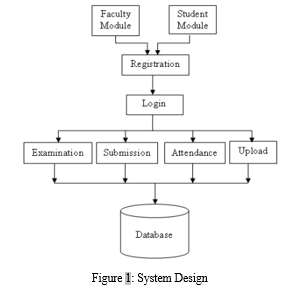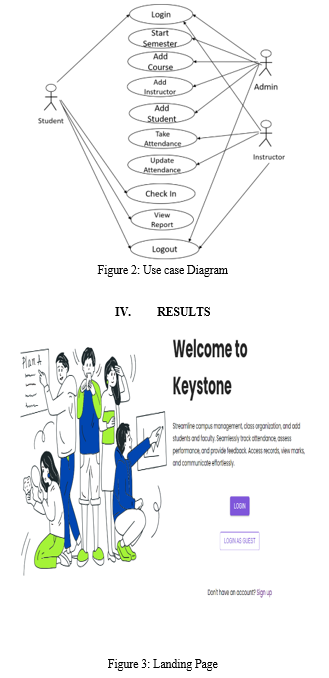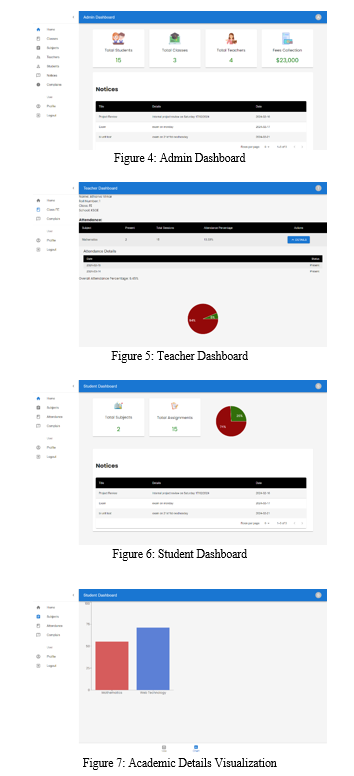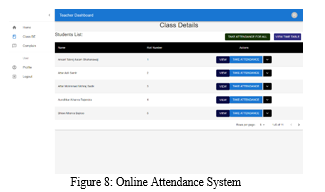Ijraset Journal For Research in Applied Science and Engineering Technology
- Home / Ijraset
- On This Page
- Abstract
- Introduction
- Conclusion
- References
- Copyright
Keystone - A Smart Campus
Authors: Prof. Sagar Rajebhosale, Prof. Rajeshwari Dandage, Mr. Atharva Virkar, Mr. Durgaprasad Chouhan, Mr. Atharva Bhise, Mr. Rushikesh Nandgavkar
DOI Link: https://doi.org/10.22214/ijraset.2024.62547
Certificate: View Certificate
Abstract
Increasing numbers of institutes have set up facilities on their Web portal as a way of providing users (i.e. Students and Faculties) with information about their facilities and features. Generally in colleges, things are done manually such as submission, handouts, notice, results, records, examinations, etc. so to avoid this we are designing a web portal for our institute, which will be helpful in following features like time saving, easy access and user friendly. In this project, we developed a Smart Campus Web Portal called Keystone App. Keystone App offers campus management solutions with the collaboration of smart features, the Internet and computer applications. The system has many features; these are Online Attendance System, Online Noticeboard, providing study materials and many more. It is a digitalization of campus resources in the real world, allowing different resources to be integrated and generating an ecology. The virtual campus interacts powerfully with the physical campus, improving the efficiency of campus operations and promoting the university\'s long-term development.
Introduction
I. INTRODUCTION
An institute is a highly interactive environment and collaboration between various entities is an integral part of its functioning. This collaboration takes place not only in the class room (i.e. between teachers and students) but also between department and students, among students, among teachers etc. In institutes, traditional methods of information sharing are like notice boards, notes, hand-outs etc. These traditional methods are not providing efficient access to information. Nowadays students would find it almost impossible to wait till next morning to meet their teachers just to get some reference material or to ask some difficulties. And certainly the teacher would also not want the students to wait. Today’s education scenario is rapidly changing and demanding. Students demand a higher level of access to information about their options, their performance, their learning environment and their future. They also demand that technology resources be an integral part of their learning experience [1]. The standard for access to faculty and student services will change as students come to expect virtual access to faculty and student services resources. This can be achieved by creating a web portal because portals are nowadays becoming increasingly popular by enabling the development and maintenance of specific communities of interest on corporate intranets or the Internet. We are designing a web portal ’Keystone’ for our institute, which will provide facilities such as submission, handouts, notice, results, records, examinations, attendance, etc to students.
A. Problem Defination
Some of the problems faced by Institutes are delays in results, marking attendance, notifying students some important notices. The chances of these problems occurring are high and it is very difficult to deal with these problem. A web portal or an application is necessary for an institute to handle these problems with ease.
Following problems can be addressed using the Keystone app :-
1. Tedious and Manual way of taking attendance.
2. Storing students information manually and having lots of paper work.
3. Teachers need to schedule a class by having to communicate to every student personally.
4. The only way of getting notices from the faculty is the noticeboard.
5. Students have to personally visit office or faculty members for getting results
B. Objective
Some major objectives of Keystone are :-
- To provide a centralized platform for students, faculty, and staff to access important information, resources, and services from anywhere, improving accessibility.
- Keystone app can streamline administrative processes, such as registration, scheduling, and grading, reducing paperwork and manual effort.
- Facilitating effective communication between different campus stakeholders, fostering collaboration, and sharing updates in real-time.
- Implementing secure access controls and data protection measures can help safeguard sensitive information.
- Encouraging student-teacher engagement through personalized features, such as class schedules, grades, and extracurricular activities, can enhance the overall campus experience.
These objectives collectively contribute to the development of Keystone web portal that benefits the entire academic community.
C. Motivation
Keystone app can provide a centralized platform for students, faculty, and staff to access important features, information, resources, and services from anywhere, improving accessibility. It can streamline administrative processes, such as registration, scheduling, and grading, reducing paperwork and manual effort. Keystone helps encourage student-teacher engagement through personalized features, such as class schedules, grades, and extracurricular activities, can enhance overall campus experience. To minimize the stress of carrying each students records manually and having a digital way to keep records and track performance and attendance, Keystone app is created.
D. Scope
This project is mainly targeted at colleges and the synchronization of all the sparse and diverse information regarding regular college schedule. Generally students face problems in getting correct notifications at the correct time, some times important notices such as campus interview, training and placement events, holidays and special announcements. Keystone app tries to bridge this gap between students, teachers and college administrators. Therefore in the real world scenario, such as college campus, the information in the form of notices, oral communication, can be directly communicated through the android devices and can be made available for the students, teachers directly for their android devices and the maintenance of application will be easier in later future because of the use of architectural MVC which separates the major works in the development of an application such as data management, mobile user interface display and web service which will be the controller to make sure for fast and efficient maintenance of application
II. LITERATURE SURVEY
|
Title |
Author |
Year |
Gap Analysis |
|
Smart Campus: An Academic Web Portal with Android Application |
Prof.Sagar Rajebhosale, Mr. Shashank Choudhari, Mr.Sachin Patil, Mr.Akshay Vyavahare, Mr.Sanket Khabiya |
2016 |
Proposed system will also help the college to manage their records an save natural resources and job gets done in less time compared to existing system. |
|
Leveraging IoT for Smart Campuses |
A. Brown and S. Lee. |
2018 |
Highlights the potential for further research in optimizing energy management and sustainability in smart campuses through IoT. |
|
Mobile App Development for Smart Campuses |
Garcia, M. and Patel, R. |
2019 |
Addresses the importance of user-friendly and feature-rich mobile apps but leaves room for exploration of AI integration. |
|
Data Privacy Challenges in Smart Campus Application |
Y. Kim and L. Chen. |
2020 |
Identifies a gap in the literature for comprehensive guidelines and legal frameworks to address data privacy concerns in educational settings. |
|
Smart Campus: A Comprehensive Review |
Smith, J. et al. |
2021 |
Identifies the need for enhanced user experience in existing smart campus applications, particularly in terms of usability and accessibility |
|
Smart Campus: Meaning, Features and Benefits |
Henry Smith |
2022 |
It offers interaction tools and self-service technology to contribute positively to classroom education and improve productivity while retaining a human- centric strategy by automating students and teachers activities. |
III. SYSTEM DESIGN
A system diagram represents the interaction between different areas or elements over a single period [8]. Below is a simple diagram representing the sequence of activities in Keystone web portal:

- User Registers into the web portal.
- Student fills Admission form.
- . Faculty enters credentials.
2. User logs-in to the web portal.
3. Students will be grouped together accordingly.
4. Different roles for different faculty members.
5. All data and records to be stored in a database.
B. System Architecture
- Frontend (React): HTML, CSS, Javascript and React are the web technologies used. The React-based front-end provides a dynamic and responsive user interface. It has many components such as control panel, test interface and maintenance contract.
- Backend (Node.JS and Express.JS): The backend is powered by Node.js and Express.js and handles the application’s business logic, routing, and data interaction. It includes various intermediate functions for customer verification, decision making and error management.
- Database (MongoDB): MongoDB plays an important role in storing usage data, index data, aggregate scores, and other related data. MongoDB’s NoSQL structure provides flexibility in data storage and retrieval.
- User Authentication: User authentication is an important part of the system to provide secure access to user-specific information. Use JWT (JSON Web Token) authentication to provide a stateless and secure way to authenticate users.
- Admin Panel: Secure authenticated admin panel provides communication to administrators. It includes tools to monitor users’ activities, manage content (questions, study materials), and perform important maintenance tasks. Managers can also access analytics and reports to understand overall performance.
- Digital Attendance System: A QR-code will be generated by the admin by which all the students can mark their attendance with just a simple scan. Another way of marking attendance is by ticking the present box given by the admin on the portal.
- Online Notice Board: Students will receive updates and important notices online on the dashboard. Teachers and faculty members can notify students online.
B. System Features
- Feature 1: Student Registration and Login This feature allows students to register and login to the web portal, securely.
Functional Requirements:
- Student registration with email or phone number.
- Secure password management and recovery options.
- Secure and Restricted access to one’s account.
For the user Benefits like: Students can register themselves to this portal and login whenever they want and access the features of this portal.
2. Feature 2: Profile Management It will allow students to create their profile, which includes their academic details and other information, and maintain their profiles for identity purpose.
Functional Requirements:
- Profile includes academic details and personal information like name, DOB, branch, year.
- Students can upload their profile picture accordingly.
- User profile editing and updates.
- Teachers can see a students profile.
For the user Benefits like: Students can their own individual profile which includes their personal information, academic details and other information and have a profile picture.
3. Feature 3: Digital Attendance System This feature will allow students to mark their attendance digitally which will reduce the manual work of teachers and save time of both students and teachers.
Functional Requirements:
- QR-code will be used to mark attendance of students.
- Teachers won’t have to do any manual work to mark attendance.
- This will reduce a lot of paper works.
- Teacher will get a final students count that are present.
For users Benefits like: Manual way of marking attendance is a hefty work and consumes a lot of time, instead students can mark their attendance digitally to avoid any paper work [3].
4. Feature 4: Receives Updates and Notices Students will get any important updates or notices on this every portal without having to see the notice board or visit the college office.
Functional Requirement:
- If a faculty is to give any notice to students they can send a message to every students portal.
- Students will get this notice on their dashboard in the notice section.
- Notices like exam form details, results collection, or else can be send to students.
- Lots of paper work will be avoided.
For users Benefits like: Students can get important updates or notices related to exam form filling, admission process, scholarship form ,etc., without having to visit the college office.
5. Feature 5: Admin login Faculty/Lectures will get special dashboard then students, and can have access to various other features which will help to monitor every student on the portal.
Functional Requirements:
- Reporting and Data Analytics Tools.
- Monitor students progress by assessing their scores and attendance.
- Can digitally schedule a class.
- Important notices and updates can be sent by teachers.
- Access to every students profile for identification purpose.
For users Benefits like: This feature will give an upperhand to the faculty members as they can monitor students performances and notify them with important updates digitally reducing a lot of manual work and saving time [4].
C. Use Case Diagram
Usecase Diagram uses a diagram to show the interaction between actors (users or external systems) and systems to achieve specific goals.[7] Figure 2 is a simple diagram for Keystone web portal.



Conclusion
The today’s world is computerized world, internet use has become widespread. The Internet has exciting Web Portal capabilities. Keystone App portal brings many resources and services that can be effectively used by many users in the same department. Our Keystone App Portal provides greater control over processes, faster workflows, less data, paperwork and more. It provides a convenient and user-friendly environment for teachers and students to interact with the system in digital ways. The Keystone Portal encourages collaboration to assist students when needed. In conclusion, Keystone App provides a wide range of features for both the students and faculty members by encouraging digital interaction, online attendance system, digital noticeboard, and many more. The main objective of Keystone App is provide a user-friendly and easy interface of communication between students and teachers. The Keystone App will also help the college manage its data, save natural resources and complete work in a shorter time than the traditional system. Due to instant availability of the request, all users can receive information without delay. It helps to reach all students and teachers of the college in a short time. The information stored in the database will help managers make major decisions regarding advice and ideas. Keystone App will help students solve their questions through the answers of other users such as classmates and university teachers. Since the system will have a large number of users, we plan to use various algorithms to secure the system and solve issues. Keystone App will help a college function digital and with ease. In essence, Keystone App is not a just web portal but a way for both the students and faculty to interact and function together.
References
[1] Sagar Rajebhosale, Shashank Choudhari, Sachin Patil, Akshay Vyavahare, and Sanket Khabiya. Smart campus–an academic web portal with android application. International Research Journal of Engineering and Technology, 3(4):389–394, 2016. [2] No´emie Chagnon-Lessard, Louis Gosselin, Simon Barnab´e, Tunde BelloOchende, Sebastian Fendt, Sebastian Goers, Luiz Carlos Pereira Da Silva, Benedikt Schweiger, Richard Simmons, Annelies Vandersickel, et al. Smart campuses: extensive review of the last decade of research and current challenges. IEEE Access, 9:124200–124234, 2021. [3] Zakiah Ayop, Chan Yee Lin, Syarulnaziah Anawar, Erman Hamid, and Muhammad Syahrul Azhar. Location-aware event attendance system using qr code and gps technology. International Journal of Advanced Computer Science and Applications, 9(9), 2018. [4] Sameer Shaik, L Sampath Kumar, M Srinithya Reddy, and G Pawan Kalyan. Smart campus-a digital transformation using iot. [5] Samkeet Jain, Radhika Garg, Vaibhavkrishna Bhosle, and Lilash Sah. Smart university-student information management system. In 2017 International Conference On Smart Technologies For Smart Nation (SmartTechCon), pages 1183–1188. IEEE, 2017. [6] Kai Yan, Jian Yang, Tianyuan Chen, Ping Huang, Hua Fu, and Man Zhang. Research on the construction path of smart campus management platform under big data. In 2023 2nd International Conference on Educational Innovation and Multimedia Technology (EIMT 2023), pages 875–882. Atlantis Press, 2023. [7] Mohammad Ali Eljinini, Jamal Zraqou, Adi A Maaita, and Wesam Alkhadour. Towards a smart campus: Smart classroom management. [8] Pratibha S Yalagi and S Dangare Chaitrali. Design of an academic web portal providing e-facilities. International Journal of Computer Science Engineering and Information Technology Research (IJCSEITR) ISSN, 2249:6831, 2013. [9] Weiguang Li. Design of smart campus management system based on internet of things technology. Journal of Intelligent & Fuzzy Systems, 40(2):3159–3168, 2021.
Copyright
Copyright © 2024 Prof. Sagar Rajebhosale, Prof. Rajeshwari Dandage, Mr. Atharva Virkar, Mr. Durgaprasad Chouhan, Mr. Atharva Bhise, Mr. Rushikesh Nandgavkar. This is an open access article distributed under the Creative Commons Attribution License, which permits unrestricted use, distribution, and reproduction in any medium, provided the original work is properly cited.

Download Paper
Paper Id : IJRASET62547
Publish Date : 2024-05-23
ISSN : 2321-9653
Publisher Name : IJRASET
DOI Link : Click Here
 Submit Paper Online
Submit Paper Online

